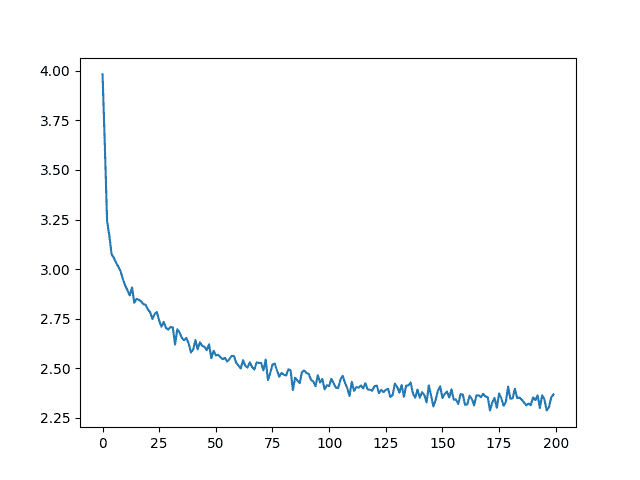从零开始的 NLP:使用字符级 RNN 生成名称
从零开始的 NLP:使用字符级 RNN 生成名称
原文:https://pytorch.org/tutorials/intermediate/char_rnn_generation_tutorial.html
作者: Sean Robertson
这是我们关于“从零开始的 NLP”的三个教程中的第二个。 在第一个教程/intermediate/char_rnn_classification_tutorial中,我们使用了 RNN 将名称分类为源语言。 这次,我们将转过来并使用语言生成名称。
> python sample.py Russian RUS
Rovakov
Uantov
Shavakov
> python sample.py German GER
Gerren
Ereng
Rosher
> python sample.py Spanish SPA
Salla
Parer
Allan
> python sample.py Chinese CHI
Chan
Hang
Iun
我们仍在手工制作带有一些线性层的小型 RNN。 最大的区别在于,我们无需输入名称中的所有字母即可预测类别,而是输入类别并一次输出一个字母。 反复预测字符以形成语言(这也可以用单词或其他高阶结构来完成)通常称为“语言模型”。
推荐读物:
我假设您至少已经安装了 PyTorch,Python 和张量:
- 安装说明
- 使用 PyTorch 进行深度学习:60 分钟的突击通常开始使用 PyTorch
- 使用示例学习 PyTorch
- PyTorch(面向以前的 Torch 用户)(如果您以前是 Lua Torch 用户)
了解 RNN 及其工作方式也将很有用:
- 《循环神经网络的不合理有效性》显示了许多现实生活中的例子
- 《了解 LSTM 网络》特别是关于 LSTM 的,但一般来说也有关 RNN 的
我还建议上一教程《从零开始的 NLP:使用字符级 RNN 对名称进行分类》
准备数据
注意
从的下载数据,并将其提取到当前目录。
有关此过程的更多详细信息,请参见上一教程。 简而言之,有一堆纯文本文件data/names/[Language].txt,每行都有一个名称。 我们将行拆分成一个数组,将 Unicode 转换为 ASCII,最后得到一个字典{language: [names ...]}。
from __future__ import unicode_literals, print_function, division
from io import open
import glob
import os
import unicodedata
import string
all_letters = string.ascii_letters + " .,;'-"
n_letters = len(all_letters) + 1 # Plus EOS marker
def findFiles(path): return glob.glob(path)
# Turn a Unicode string to plain ASCII, thanks to https://stackoverflow.com/a/518232/2809427
def unicodeToAscii(s):
return ''.join(
c for c in unicodedata.normalize('NFD', s)
if unicodedata.category(c) != 'Mn'
and c in all_letters
)
# Read a file and split into lines
def readLines(filename):
lines = open(filename, encoding='utf-8').read().strip().split('\n')
return [unicodeToAscii(line) for line in lines]
# Build the category_lines dictionary, a list of lines per category
category_lines = {}
all_categories = []
for filename in findFiles('data/names/*.txt'):
category = os.path.splitext(os.path.basename(filename))[0]
all_categories.append(category)
lines = readLines(filename)
category_lines[category] = lines
n_categories = len(all_categories)
if n_categories == 0:
raise RuntimeError('Data not found. Make sure that you downloaded data '
'from https://download.pytorch.org/tutorial/data.zip and extract it to '
'the current directory.')
print('# categories:', n_categories, all_categories)
print(unicodeToAscii("O'Néàl"))
出:
# categories: 18 ['French', 'Czech', 'Dutch', 'Polish', 'Scottish', 'Chinese', 'English', 'Italian', 'Portuguese', 'Japanese', 'German', 'Russian', 'Korean', 'Arabic', 'Greek', 'Vietnamese', 'Spanish', 'Irish']
O'Neal
创建网络
该网络扩展最后一个教程的 RNN,并为类别张量附加了一个参数,该参数与其他张量连接在一起。 类别张量就像字母输入一样是一个单向向量。
我们将输出解释为下一个字母的概率。 采样时,最可能的输出字母用作下一个输入字母。
我添加了第二个线性层o2o(在合并了隐藏和输出之后),以使其有更多的肌肉可以使用。 还有一个丢弃层,以给定的概率(此处为 0.1)将输入的部分随机归零,通常用于模糊输入以防止过拟合。 在这里,我们在网络的末端使用它来故意添加一些混乱并增加采样种类。

import torch
import torch.nn as nn
class RNN(nn.Module):
def __init__(self, input_size, hidden_size, output_size):
super(RNN, self).__init__()
self.hidden_size = hidden_size
self.i2h = nn.Linear(n_categories + input_size + hidden_size, hidden_size)
self.i2o = nn.Linear(n_categories + input_size + hidden_size, output_size)
self.o2o = nn.Linear(hidden_size + output_size, output_size)
self.dropout = nn.Dropout(0.1)
self.softmax = nn.LogSoftmax(dim=1)
def forward(self, category, input, hidden):
input_combined = torch.cat((category, input, hidden), 1)
hidden = self.i2h(input_combined)
output = self.i2o(input_combined)
output_combined = torch.cat((hidden, output), 1)
output = self.o2o(output_combined)
output = self.dropout(output)
output = self.softmax(output)
return output, hidden
def initHidden(self):
return torch.zeros(1, self.hidden_size)
训练
准备训练
首先,辅助函数获取随机对(类别,行):
import random
# Random item from a list
def randomChoice(l):
return l[random.randint(0, len(l) - 1)]
# Get a random category and random line from that category
def randomTrainingPair():
category = randomChoice(all_categories)
line = randomChoice(category_lines[category])
return category, line
对于每个时间步(即,对于训练词中的每个字母),网络的输入将为(category, current letter, hidden state),而输出将为(next letter, next hidden state)。 因此,对于每个训练集,我们都需要类别,一组输入字母和一组输出/目标字母。
由于我们正在预测每个时间步中当前字母的下一个字母,因此字母对是该行中连续字母的组-例如对于"ABCD<EOS>",我们将创建('A', 'B'), ('B', 'C'), ('C', 'D'), ('D', 'EOS')。

类别张量是大小为<1 x n_categories>的单热张量。 训练时,我们会随时随地将其馈送到网络中-这是一种设计选择,它可能已作为初始隐藏状态或某些其他策略的一部分包含在内。
# One-hot vector for category
def categoryTensor(category):
li = all_categories.index(category)
tensor = torch.zeros(1, n_categories)
tensor[0][li] = 1
return tensor
# One-hot matrix of first to last letters (not including EOS) for input
def inputTensor(line):
tensor = torch.zeros(len(line), 1, n_letters)
for li in range(len(line)):
letter = line[li]
tensor[li][0][all_letters.find(letter)] = 1
return tensor
# LongTensor of second letter to end (EOS) for target
def targetTensor(line):
letter_indexes = [all_letters.find(line[li]) for li in range(1, len(line))]
letter_indexes.append(n_letters - 1) # EOS
return torch.LongTensor(letter_indexes)
为了方便训练,我们将使用randomTrainingExample函数来获取随机(类别,行)对,并将其转换为所需的(类别,输入,目标)张量。
# Make category, input, and target tensors from a random category, line pair
def randomTrainingExample():
category, line = randomTrainingPair()
category_tensor = categoryTensor(category)
input_line_tensor = inputTensor(line)
target_line_tensor = targetTensor(line)
return category_tensor, input_line_tensor, target_line_tensor
训练网络
与仅使用最后一个输出的分类相反,我们在每个步骤进行预测,因此在每个步骤都计算损失。
Autograd 的神奇之处在于,您可以简单地在每个步骤中对这些损失进行求和,然后在末尾调用。
criterion = nn.NLLLoss()
learning_rate = 0.0005
def train(category_tensor, input_line_tensor, target_line_tensor):
target_line_tensor.unsqueeze_(-1)
hidden = rnn.initHidden()
rnn.zero_grad()
loss = 0
for i in range(input_line_tensor.size(0)):
output, hidden = rnn(category_tensor, input_line_tensor[i], hidden)
l = criterion(output, target_line_tensor[i])
loss += l
loss.backward()
for p in rnn.parameters():
p.data.add_(p.grad.data, alpha=-learning_rate)
return output, loss.item() / input_line_tensor.size(0)
为了跟踪训练需要多长时间,我添加了一个timeSince(timestamp)函数,该函数返回人类可读的字符串:
import time
import math
def timeSince(since):
now = time.time()
s = now - since
m = math.floor(s / 60)
s -= m * 60
return '%dm %ds' % (m, s)
训练照常进行-召集训练多次并等待几分钟,每print_every个示例打印当前时间和损失,并在all_losses中保存每个plot_every实例的平均损失以供以后绘制。
rnn = RNN(n_letters, 128, n_letters)
n_iters = 100000
print_every = 5000
plot_every = 500
all_losses = []
total_loss = 0 # Reset every plot_every iters
start = time.time()
for iter in range(1, n_iters + 1):
output, loss = train(*randomTrainingExample())
total_loss += loss
if iter % print_every == 0:
print('%s (%d %d%%) %.4f' % (timeSince(start), iter, iter / n_iters * 100, loss))
if iter % plot_every == 0:
all_losses.append(total_loss / plot_every)
total_loss = 0
出:
0m 26s (5000 5%) 3.2265
0m 51s (10000 10%) 3.0171
1m 16s (15000 15%) 2.1535
1m 41s (20000 20%) 2.0806
2m 7s (25000 25%) 2.3842
2m 32s (30000 30%) 2.5014
2m 57s (35000 35%) 2.2441
3m 22s (40000 40%) 2.2113
3m 47s (45000 45%) 2.1184
4m 13s (50000 50%) 1.3983
4m 38s (55000 55%) 2.5881
5m 3s (60000 60%) 1.8033
5m 29s (65000 65%) 2.4285
5m 54s (70000 70%) 2.4198
6m 20s (75000 75%) 2.9660
6m 45s (80000 80%) 1.9752
7m 11s (85000 85%) 3.7507
7m 36s (90000 90%) 2.2044
8m 2s (95000 95%) 2.8938
8m 27s (100000 100%) 2.2471
绘制损失图
绘制all_loss的历史损失可显示网络学习情况:
import matplotlib.pyplot as plt
import matplotlib.ticker as ticker
plt.figure()
plt.plot(all_losses)

网络采样
为了示例,我们给网络一个字母,询问下一个字母是什么,将其作为下一个字母输入,并重复直到 EOS 标记。
- 为输入类别,起始字母和空隐藏状态创建张量
- 用起始字母创建一个字符串
output_name - 直到最大输出长度,
- 将当前字母输入网络
- 从最高输出中获取下一个字母,以及下一个隐藏状态
- 如果字母是
EOS,请在此处停止 - 如果是普通字母,请添加到
output_name并继续
- 返回姓氏
注意
不必给它起一个开始字母,另一种策略是在训练中包括一个“字符串开始”标记,并让网络选择自己的开始字母。
max_length = 20
# Sample from a category and starting letter
def sample(category, start_letter='A'):
with torch.no_grad(): # no need to track history in sampling
category_tensor = categoryTensor(category)
input = inputTensor(start_letter)
hidden = rnn.initHidden()
output_name = start_letter
for i in range(max_length):
output, hidden = rnn(category_tensor, input[0], hidden)
topv, topi = output.topk(1)
topi = topi[0][0]
if topi == n_letters - 1:
break
else:
letter = all_letters[topi]
output_name += letter
input = inputTensor(letter)
return output_name
# Get multiple samples from one category and multiple starting letters
def samples(category, start_letters='ABC'):
for start_letter in start_letters:
print(sample(category, start_letter))
samples('Russian', 'RUS')
samples('German', 'GER')
samples('Spanish', 'SPA')
samples('Chinese', 'CHI')
出:
Rovanov
Uarinov
Santovov
Gangerten
Erer
Roure
Salla
Parera
Allan
Chin
Han
Iun
练习
- 尝试使用类别 -> 行的其他数据集,例如:
- 虚构序列 -> 角色名称
- 词性 -> 词
- 国家 -> 城市
- 使用“句子开头”标记,以便无需选择开始字母即可进行采样
- 通过更大和/或形状更好的网络获得更好的结果
- 尝试
nn.LSTM和nn.GRU层 - 将多个这些 RNN 合并为更高级别的网络
- 尝试
脚本的总运行时间:(8 分钟 27.431 秒)
下载 Python 源码:char_rnn_generation_tutorial.py
下载 Jupyter 笔记本:char_rnn_generation_tutorial.ipynb
由 Sphinx 画廊生成的画廊